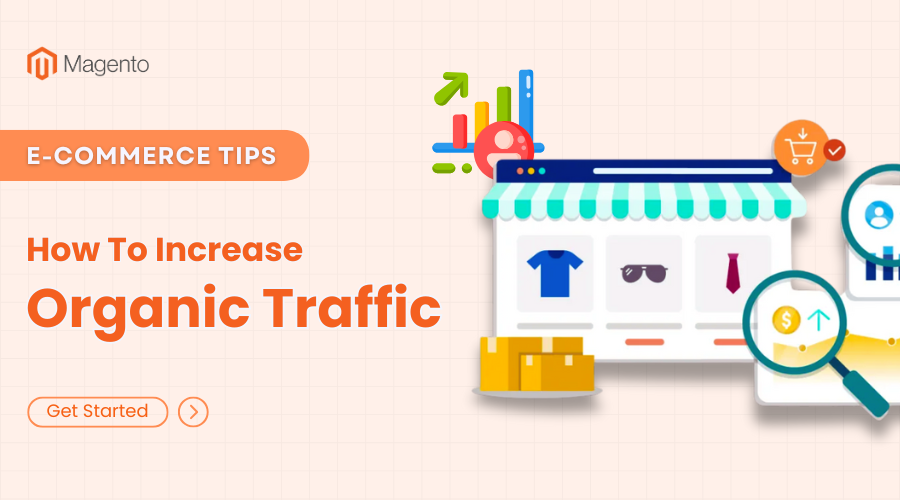
Starting an e-commerce brand is not always a matter of building a powerful product. Your product may not reach its full potential if it lacks exposure among your target audience. You still have to think about how to bring in more people to your website because that’s the only way you can secure sales.
You can depend on email marketing and social media to reel in traffic towards your e-commerce website but it’s organic traffic that boosts your brand’s long-term success. When you have people actively searching for the products you sell, it won’t take long for them to decide whether to buy from your brand. High organic traffic also indicates better relevance and authority so you may consider it a brand-building metric. Let’s look at some of the ways you can increase your e-commerce website’s monthly organic traffic.
Table of Contents
5 tips to increase organic traffic for e-commerce sites
Without further ado, let’s go through the top-tier tips to attract more and more visitors for your e-commerce online store.
Tip 1. Assess the environment online
First off, you need to learn how your audience behaves while using search engines to look for the products they need. Websites containing relevant content and allowing users to stay for a long duration tend to perform better in generating organic traffic. With search engines like Google emphasizing user experience as a significant metric for determining website authority, you may as well start by learning what search engine users want from you. The best way to do that is to conduct thorough market research, one that allows you to discover the talking points, the types of content, and the tools and widgets that elevate their experience.
Aside from that, you will also need to understand the keywords used by your target audience as well as the strategies employed by your competitors that allow them to generate high volumes of organic traffic. For this, you may use tools like SpyFu or Ahrefs to conduct keyword research, identify the most common questions asked by your audience, and gather insights that can help you refine your website for greater exposure. All of these will eventually pay off as your website reels in active users towards your products.
Tip 2. Use the right layout and design

A major factor determining your website’s searchability is how it appears to first-time visitors. You won’t encourage people to purchase your offers if the platform uses a confusing layout. With user-friendliness being a significant factor in improving a website’s visibility, you will want your platform to be intuitive and navigable. At this point, it matters a lot to select a website design that aligns with the goals of your e-commerce brand and, at the same time, tackles Google’s Core Web Vitals.
For this, consider looking around for a theme that seamlessly adapts to any screen size and allows for better readability and navigability. In today’s e-commerce market, having fewer design elements allows for greater user retention, so depending on your platform’s branding, opt for a more minimalist theme that’s easy to deploy and customize.
A good recommendation is a Blocksy theme that’s e-commerce-ready and compatible with Gutenberg. It also helps if your website strikes the perfect balance between text and visual content. When users like what they’re seeing on your website, search engines like Google view it as a strong indicator of relevance and authority which also influences your platform’s ranking in the search results.
Tip 3. Improve website performance
Building a website that generates a considerable amount of organic traffic isn’t just a matter of choosing a great layout. Your platform might be visually-engaging and intuitive but users are still likely to bounce away if it doesn’t function just as well as it looks.
Slow loading speeds as well as frequent crashes can prompt users to leave your platform without so much as adding a product to their online cart. This also causes your website’s domain authority to diminish thereby affecting its ability to generate organic traffic. For this reason, it’s important to check if your website’s technical performance is optimal.
A good way to know that is by checking its average loading speed. If it takes more than two seconds for a product page to load, it could be that your website is suffering from bloated code. You can fix this by minifying your CSS and JavaScript files as well as compressing large images. You may further limit the number of HTTP requests your website sends out by using a content delivery network.
You can also go so far as to switch to a more efficient and secure web hosting service that delivers faster loading speeds, especially as you anticipate a spike in organic visits. By implementing these improvements, your website is more likely to reach the top spot of the search results as Google observes a surge in engagement.
Tip 4. Implement the most effective SEO strategies
Apart from the technical aspects of improving your e-commerce platform, it’s also important to double down on optimization techniques that further boost your website’s visibility to organic users. This would mean coming up with a list of keywords and queries your business should rank for, and incorporating these terms in your website’s content, especially your About Us page and individual product pages. Remember to use schema markup and include complete descriptions so that your products appear as rich results that help generate better click-throughs.
To further increase your website’s visibility, consider posting guest blogs on authority websites related to your industry. The links you build on these websites will not only direct referral traffic but also increase your e-commerce platform’s relevance and reliability. With AI now being more prominent as a search engine feature, you will need to make your website AI-ready by writing content using natural language and focusing on semantic search by incorporating terms related to the products you’re selling.
Tip 5. Monitor and calibrate the platform

Keep in mind that a successful e-commerce website must undergo continuous improvement considering that search engine ranking policies change over time. It would help if you could set benchmarks to gauge whether the improvements you’ve made produced the outcomes you want.
Aside from measuring your website’s organic traffic, you should also look at other areas such as the bounce rate which shows you how well it retains new visitors. The cart abandonment rate is also crucial as this lets you know if there’s anything you need to improve in the checkout process.
To ensure every dollar you spend on your website yields the best returns, include the conversion rate in your reporting and consider the average value of all transactions made by organic visitors. Be ready to change aspects of your website’s layout and performance accordingly so you will be able to maintain or improve its position in the search engine results pages.
Endnote
Grow your e-commerce brand by building a website that both new customers and search engines love. Consider these tips to get more organic traffic, and set yourself up for more sales.












![[SALE OFF] Discount 30% All Premium Extensions On Christmas And New Year 2025 christmas-and-new-year-2025](https://landofcoder.b-cdn.net/wp-content/uploads/2024/12/christmas-and-new-year-2025-1-218x150.png)







